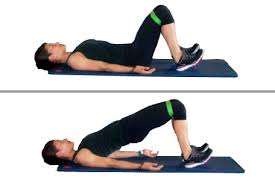While weight bearing Gluteus medius muscle acts as a pelvic stabilizer. In fact,Injuries are common amongst runners, particularly as athletes increase speeds, distances or vary training programs.
The Gluteus Medius is one of the most important, yet often forgotten muscles in preventing and rehabilitating running injuries both around the hip or further down the leg at the knee or ankle/foot. Adequate strength, activation and endurance of the Gluteus Medius muscle is required to allow optimization of biomechanics for walking, running and for reducing further injuries. So it implicates the necessities of Gluteus Medius rehabilitation after the running injuries
Gluteus Medius - Anatomy
The Gluteus Medius is of three major gluteus muscles and originates on the outer surface of the ilium (pelvis) just below the iliac crest and converges as a large flattened tendon onto the lateral greater trochanter of the femur (thigh bone).

This allows the Gluteus Medius to act as a hip flexor and internal rotator (anterior) or a hip extender and external rotator (posterior) depending on what portion of the muscle is firing. When the whole muscle fires together it acts as well as a hip abductor (lifts the leg to the side) and pelvic stabilizer during weight bearing – especially running.
What Does For My Running?
In short, this means the Gluteus Medius helps to absorb ground reaction forces as the foot strikes the ground, stops an inward movement of the knee (adduction) and steadies the pelvis over the leg as you load the lower limb.
If this muscle is overloaded because it is weak or has been worked beyond its capacity, injury can occur within the Gluteus Medius muscle or it can allow load to be transmitted onto other structures, often due to a loss of good biomechanics.
Injuries Influenced By A Poorly Functioning or Overloaded Gluteus Medius
The injuries include, but are not limited to:
- Gluteal Tendinopathy
- Gluteal Muscle Strain or Tear
- Patellofemoral Joint Pain Syndrome / Anterior Knee Pain
- ITB Friction Syndrome
- Achilles Tendinopathy
- Hamstring Injuries
- Hip and Knee Osteoarthritis
- Piriformis Syndrome
- Trochanteric Bursitis
Risk Factors for Gluteus Medius Overload
- Female
- Previous Injury to hip and its surrounding musculature
- Sudden increase in training load – speed, distance, frequency
- Change in running surfaces or running shoes
- High impact sports or fast change of direction in sports
- Repetitive loading in sports such as running
- Poor static posture
- Poor trunk and lumbar control
Rehabilitation and Prevention Exercises for Your Gluteus Medius Injury
Correct rehabilitation of your injury is essential for a successful return to sport with a minimal risk of re-injury.
Your physiotherapist will safely guide you through your rehabilitation program depending on the type and severity of injury, biomechanics, other preexisting injuries and the sport you participate in and will return back to.
Research shows that integration of trunk and lumbar stability exercises can further reduce loading onto and requirements of the Gluteus Medius. A progressive return to running and sport program will be developed as a part of your rehabilitation program.
If you have an injury it is crucial that you have a proper diagnosis and rehabilitation program from your physiotherapist but below you can find some exercises to help activate and strengthen your Gluteus Medius muscle and reduce your risk of future related running injuries.
Exercises & Videos to Help You Prevent Gluteus Medius Overload
I’d recommend the following exercises.
Loop a medium band around knees with feet shoulder width apart. LIft rear off mat while pushing knees outward toward band. Hold and slowly return.
Ball at the wall squat: By placing an exercise ball between you and a wall, a standard squat position becomes a wall squat. Wall squats focus on working the lower body and are great for working the quadriceps (front of the legs) and the butt.
Crab walk:
Begin by sitting on the floor with your feet hip-distance apart in front of you and your arms behind your back with fingers facing hips. Lift hips off the floor and tighten your abs. Start “walking” forward by moving your left hand followed by your right foot; and then your right hand followed by your left foot. Walk four or more steps as space allows, then walk back. Continue back and forth for desired amount of time
Monster walk


No comments:
Post a Comment